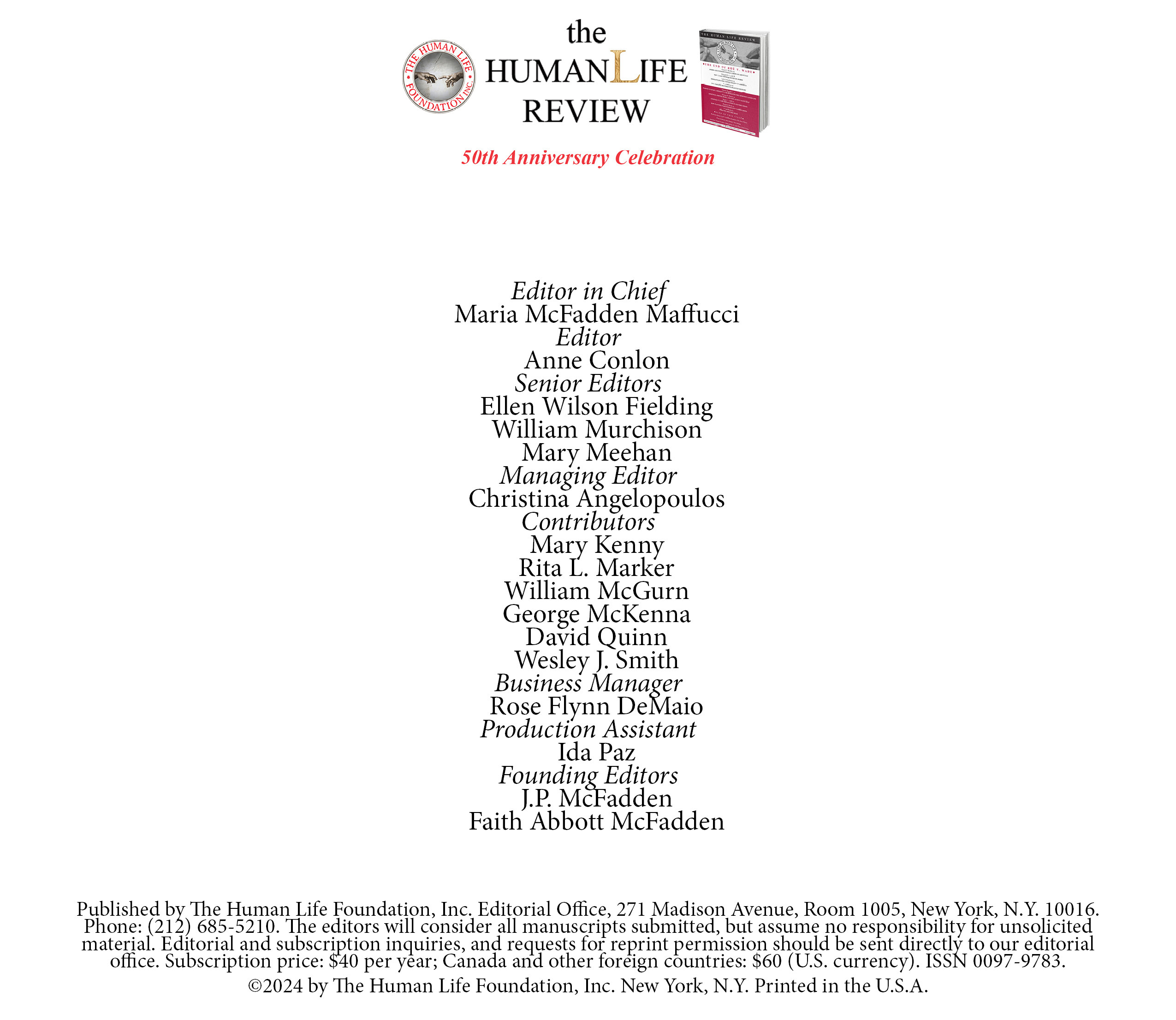| Hover and click over an underlined article to read, or select article below issue!
|
 - About this issue . . .
. . . This issue marks the first in the 50th anniversary year of the Foundation, which was incorporated in New York City in 1974. Journalist and publisher (at National Review) James P. McFadden—whose life’s journey was abruptly re-routed in the aftermath of the Roe v. Wade decision—realized both that fighting for the unborn was now his cause, and that every great movement needed a flagship publication. He also wanted to do something tangible to help women find alternatives to abortion. And so the Foundation was created, with purposes both charitable—grants to pregnancy centers—and educational, in what would be the quarterly journal the Human Life Review as well as many pamphlets and books.
J.P., who died in 1998, didn’t live to see that his Review outlived Roe! But we sure did, and here we are, starting our 50th year of uninterrupted publishing, both in print and on our website–www.humanlifereview.com—where you can also find terrific blogs, important news items, inspiring pastoral reflections, and our entire Review archive. And it’s a good thing we are: The Dobbs ruling unleashed an unprecedented level of fury against our cause—read Stephen Vincent’s “A Case for Rescue” (p. 41) on the peaceful protestors in jail!—as well as a slew of complicated maneuvers on both sides of the debate. We need to be here to break it all down for you and to shore up the defenders of life.
J.P. was convinced that the most brilliant minds of the day had to be on the side of life and, after 49 years of publishing great voices for the cause, we agree. Our current collection is an eminent example, and in it we welcome two new contributors. First, the Reverend John Bossert Brown, Jr., whose article “A House Divided” is both an indictment of the support for abortion among so many Christian churches and a plea for Christians to take “discipleship more seriously—in the home, in churches and in every Christian endeavor.” In “Ill-Informed: Abortion and the Moral Imagination,” Chris Humphrey zeroes in on what’s lacking in abortion debates: a cognizant imagination. An embryo might look less “real” than a fully-formed fetus, but both are equally human; “the imagination needs to be informed with facts, and the heart must follow.”
Three superb books are highlighted in this issue, two of them by longtime contributors: Hadley Arkes’s Mere Natural Law (Regnery Gateway), reviewed by Tom Shakely in Appendix A; and Edward Short’s What the Bells Sang: Essays and Reviews (Gracewing), reviewed by Ellen Wilson Fielding in Booknotes, which also features John Grondelski’s review of Stephen E. Doran’s To Die Well: A Catholic Neurosurgeon’s Guide to the End of Life (Ignatius Press). Finally, we complete these pages with something special. Our beloved cartoonist, Nick Downes, came out of retirement to create a brilliant 50th anniversary cartoon (p. 96) at our request. Thank you, Nick, and thanks to our readers for staying with us. Onward!
Maria McFadden Maffucci
Editor in Chief
- As I write, the news that Kate Cox, who unsuccessfully sued for an exception to Texas’s strict abortion ban, will be a guest of the Bidens at the State of the Union Speech signals prolifers are in for a pounding between now and the November election. But of course we knew that. “Abortion,” writes senior editor William Murchison in “The Tragedy of Kate Cox,” was a moral question “until it became a political question, in a world of polls and votes,” where children are “numbers in a game of power, where votes count as much as prayers. If not more so.” And while anyone who reads beyond the headlines will see in fact that Mrs. Cox‘s pregnancy (now terminated along with her lawsuit) presented the hardest of hard cases, it is nonetheless sad—even bewildering—that she would allow herself to be used as a pawn in a game of power whose goal isn’t to win legal abortion for hard cases but to make even healthy unborn children at any stage of gestation as casually discardable as garbage. “Laws,” Murchison bemoans, “often lead to yelling and screeching and the drawing of lines in the sand.” Today many prolifers appear ready to abandon the legal route, at least for a while, arguing that only by first winning hearts and minds will we ever achieve lasting legislative success. But then someone like John Bossert Brown Jr. poses the uncomfortable question: “Why,” the retired pastor and author asks in “A House Divided,” which follows Murchison, “should we think that the world will pay attention to the sanctity of life if substantial numbers of Christians fail to take it seriously?” In fact, millions of them already “accept the legality of abortion.” Brown cites recent surveys showing over 50 percent of American women who have abortions “identify as Christians,” and of these “40 percent identify as Catholic and Evangelical,” findings that “constitute a tragedy of epic proportions” and “are particularly lamentable because the sanctity of human life is rooted in the Christian faith—in the biblical story, in the Christian worldview.” Abortion, he reminds us, “was not all that rare in the ancient world.”
Read More
|
